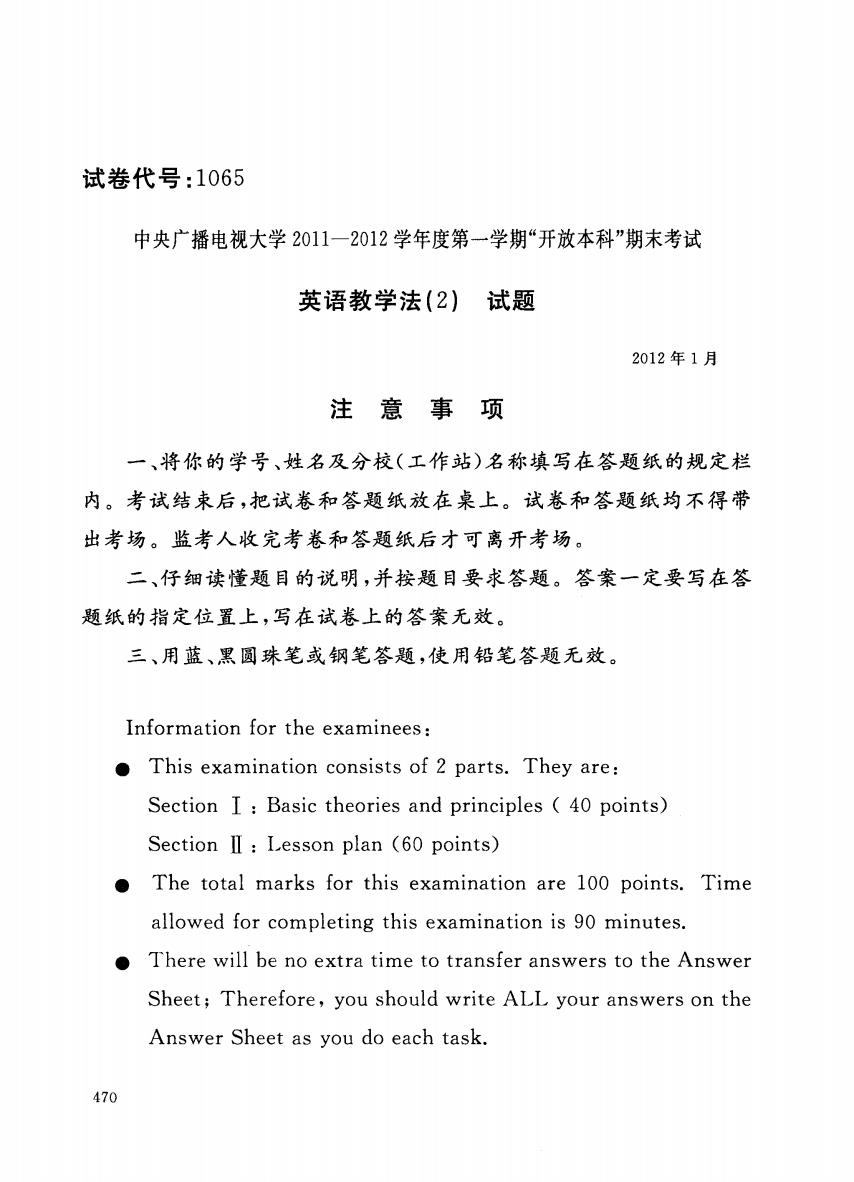
试卷代号:1065 中央广播电视大学2011一2012学年度第一学期“开放本科”期末考试 英语教学法(2)试题 2012年1月 注意事项 一、将你的学号、姓名及分校(工作站)名称填写在答题纸的规定栏 内。考试结束后,把试卷和答题纸放在桌上。试卷和答题纸均不得带 出考场。监考人收完考卷和答题纸后才可离开考场。 二、仔细读懂题目的说明,并按题目要求答题。答案一定要写在答 题纸的指定位置上,写在试卷上的答案无效。 三、用蓝、黑圆珠笔或钢笔答题,使用铅笔答题无效。 Information for the examinees: o This examination consists of 2 parts.They are: Section I:Basic theories and principles (40 points) SectionⅡ:Lesson plan(60 points) The total marks for this examination are 100 points.Time allowed for completing this examination is 90 minutes. o There will be no extra time to transfer answers to the Answer Sheet;Therefore,you should write ALL your answers on the Answer Sheet as you do each task. 470
试卷代号 中央广播电视大学 2 0 2学年度第一学期"开放本科"期未考试 英语教学法 )试题 2012 年1 事项 一、将你的学号、姓名及分校(工作站)名称填写在答题纸的规定栏 内。考试结束后,把试卷和答题纸放在桌上。试卷和答题纸均不得带 出考场。监考人收完考卷和答题纸后才可离开考场。 二、仔细读懂题目的说明,并按题目要求答题。答案一定要写在答 题纸的指定位置上,写在试卷上的答案无效。 三、用蓝、黑圆珠笔或钢笔答题,使用铅笔答题无效。 Information for the examinees: • This examination consists of 2 parts. They are: Section I : Basic theories and principles ( 40 points) Section II : Lesson plan (60 points) • The total marks for this examination are 100 points. Time allowed for completing this examination is 90 minutes. • There will be no extra time to transfer answers to the Answer Sheet; Therefore , you should write ALL your answers on the Answer Sheet as you do each task. 470
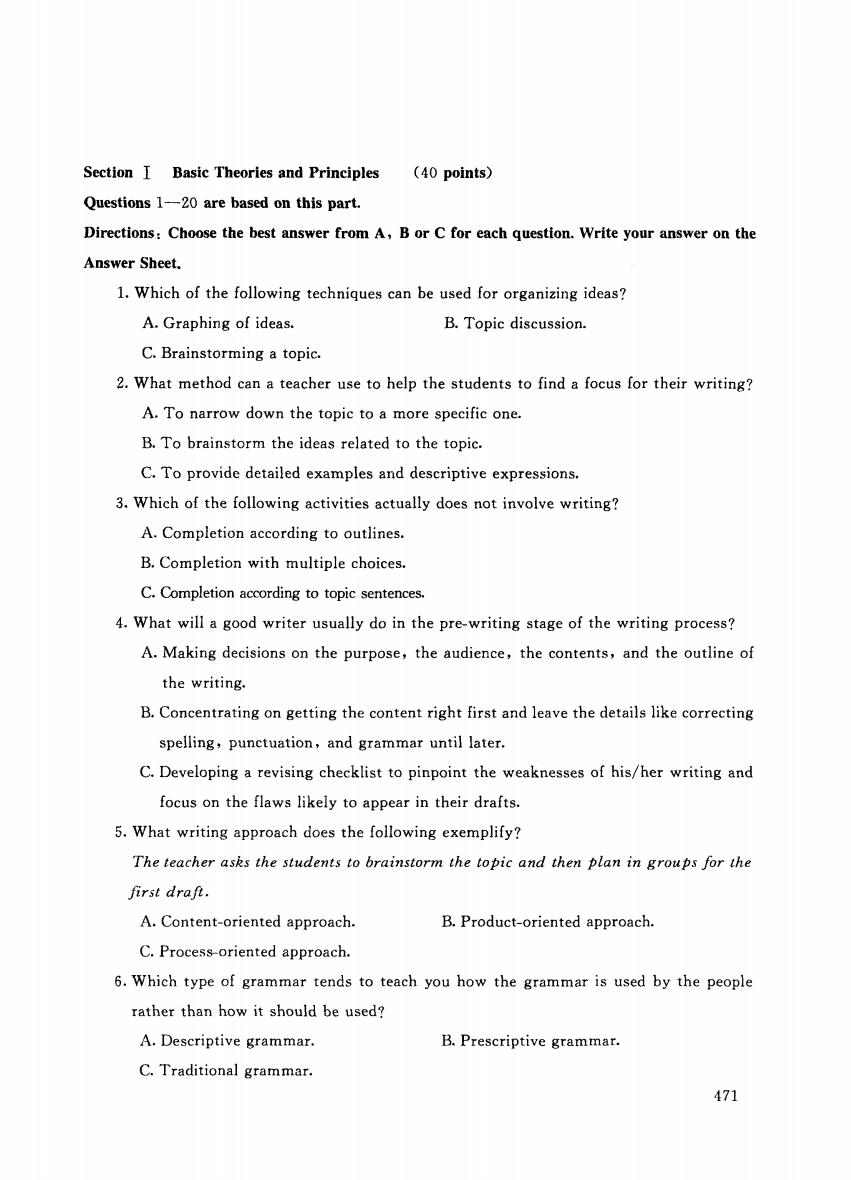
Section I Basic Theories and Principles (40 points) Questions 1-20 are based on this part. Directions:Choose the best answer from A,B or C for each question.Write your answer on the Answer Sheet. 1.Which of the following techniques can be used for organizing ideas? A.Graphing of ideas. B.Topic discussion. C.Brainstorming a topic. 2.What method can a teacher use to help the students to find a focus for their writing? A.To narrow down the topic to a more specific one. B.To brainstorm the ideas related to the topic. C.To provide detailed examples and descriptive expressions. 3.Which of the following activities actually does not involve writing? A.Completion according to outlines. B.Completion with multiple choices. C.Completion according to topic sentences. 4.What will a good writer usually do in the pre-writing stage of the writing process? A.Making decisions on the purpose,the audience,the contents,and the outline of the writing. B.Concentrating on getting the content right first and leave the details like correcting spelling,punctuation,and grammar until later. C.Developing a revising checklist to pinpoint the weaknesses of his/her writing and focus on the flaws likely to appear in their drafts. 5.What writing approach does the following exemplify? The teacher asks the students to brainstorm the topic and then plan in groups for the first draft. A.Content-oriented approach. B.Product-oriented approach. C.Process-oriented approach. 6.Which type of grammar tends to teach you how the grammar is used by the people rather than how it should be used? A.Descriptive grammar. B.Prescriptive grammar. C.Traditional grammar. 471
(40 points) B. Topic discussion. B. Product-oriented approach. Section I Basic Theories and Principles Questions 1-20 are based on this 盯t. Directions: Choose the best answer from A, B or C for each question. Write your answer on the Answer Sheet. 1. Which of the following techniques can be used for organizing ideas? A. Graphing of ideas. C. Brainstorming a topic. 2. What method can a teacher use to help the students to find a focus for their writing? A. To narrow down the topic to a more specific one. B. To brainstorm the ideas related to the topic. C. To provide detailed examples and descriptive expressions. 3. N"hich of the following activities actually does not involve writing? A. Completion according to outlines. B. Completion with multiple choices. C. Completion according to topic sentences. 4. What will a good writer usually do in the pre-writing stage of the writing process? A. Making decisions on the purpose , the audience , the contents, and the outline of the writing. B. Concentrating on getting the content right first and leave the details like correcting spelling , punctuation , and grammar until later. C. Developing a revising checklist to pinpoint the weaknesses of his/her writing and focus on the flaws likely to appear in their drafts. 5. What writing approach does the following exemplify? The teacher asks the students to brainstorm the topic and then plan in grou户for the dra A. Content-oriented approach. C. Process-oriented approach. 6. Which type of grammar tends to teach you how the grammar is used by the people rather than how it should be used? A. Descriptive grammar. C. Traditional grammar. B. Prescriptive grammar. 471
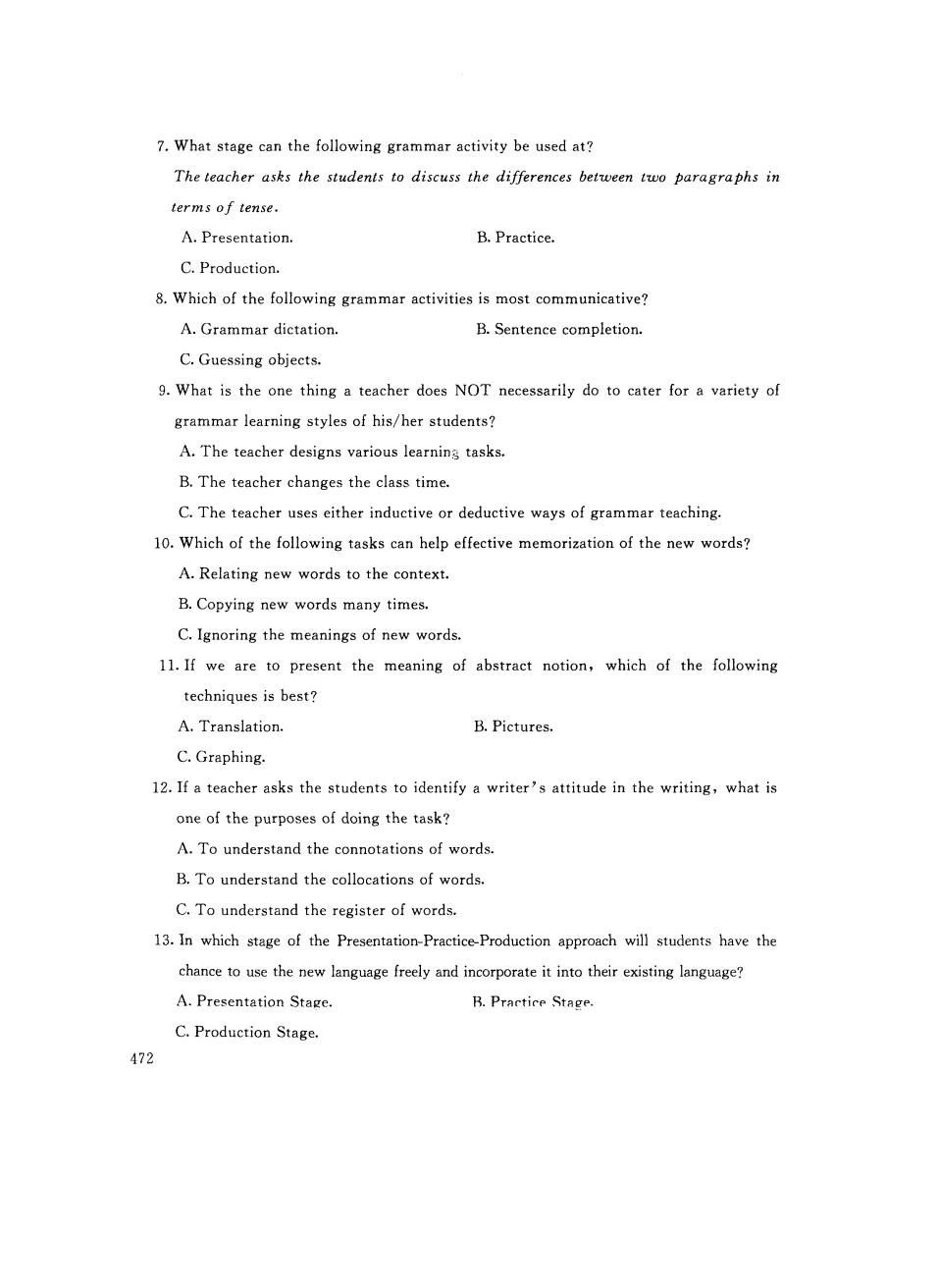
7.What stage can the following grammar activity be used at? The teacher asks the students to discuss the differences between two paragraphs in terms of tense. A.Presentation. B.Practice. C.Production. 8.Which of the following grammar activities is most communicative? A.Grammar dictation. B.Sentence completion. C.Guessing objects. 9.What is the one thing a teacher does NOT necessarily do to cater for a variety of grammar learning styles of his/her students? A.The teacher designs various learning tasks. B.The teacher changes the class time. C.The teacher uses either inductive or deductive ways of grammar teaching. 10.Which of the following tasks can help effective memorization of the new words? A.Relating new words to the context. B.Copying new words many times. C.Ignoring the meanings of new words. 11.If we are to present the meaning of abstract notion,which of the following techniques is best? A.Translation. B.Pictures. C.Graphing. 12.If a teacher asks the students to identify a writer's attitude in the writing,what is one of the purposes of doing the task? A.To understand the connotations of words. B.To understand the collocations of words. C.To understand the register of words. 13.In which stage of the Presentation-Practice-Production approach will students have the chance to use the new language freely and incorporate it into their existing language? A.Presentation Stage. B.Practice Stage. C.Production Stage. 472
7. What stage can the following grammar activity be used at? The teacher as的the students to discuss the differences between two paragraphs in terms of tense. A. Presentation. B. Practice. C. Production. 8. Which of the following grammar activities is most communicative? A. Grammar dictation. B. Sentence completion. C. Guessing objects. 9. What is the one thing a teacher does NOT necessarily do to cater for a variety of grammar learning styles of his/her students? A. The teacher designs various learning tasks. B. The teacher changes the class time. C. The teacher uses either inductive or deductive ways of grammar teaching. 10. Which of the following tasks can help effective memorization of the new words? A. Relating new words to the context. B. Copying new words many times. C. Ignoring the meanings of new words. 11. If we are to present the meaning of abstract notion , which of the following techniques is best? A. Translation. B. Pictures. C. Graphing. 12. If a teacher asks the students to identify a writer' s attitude in the writing , what is one of the purposes of doing the task? A. To understand the connotations of words. B. To understand the collocations of words. C. To und巳rstand the register of words. 13. In which stage of the Presentation-Practice-Production approach will students have the chance to use the new language freely and incorporate it into their existing language? 472 A. Presentation Stage. C. Production Stage. R. P TiH'tirp StallP
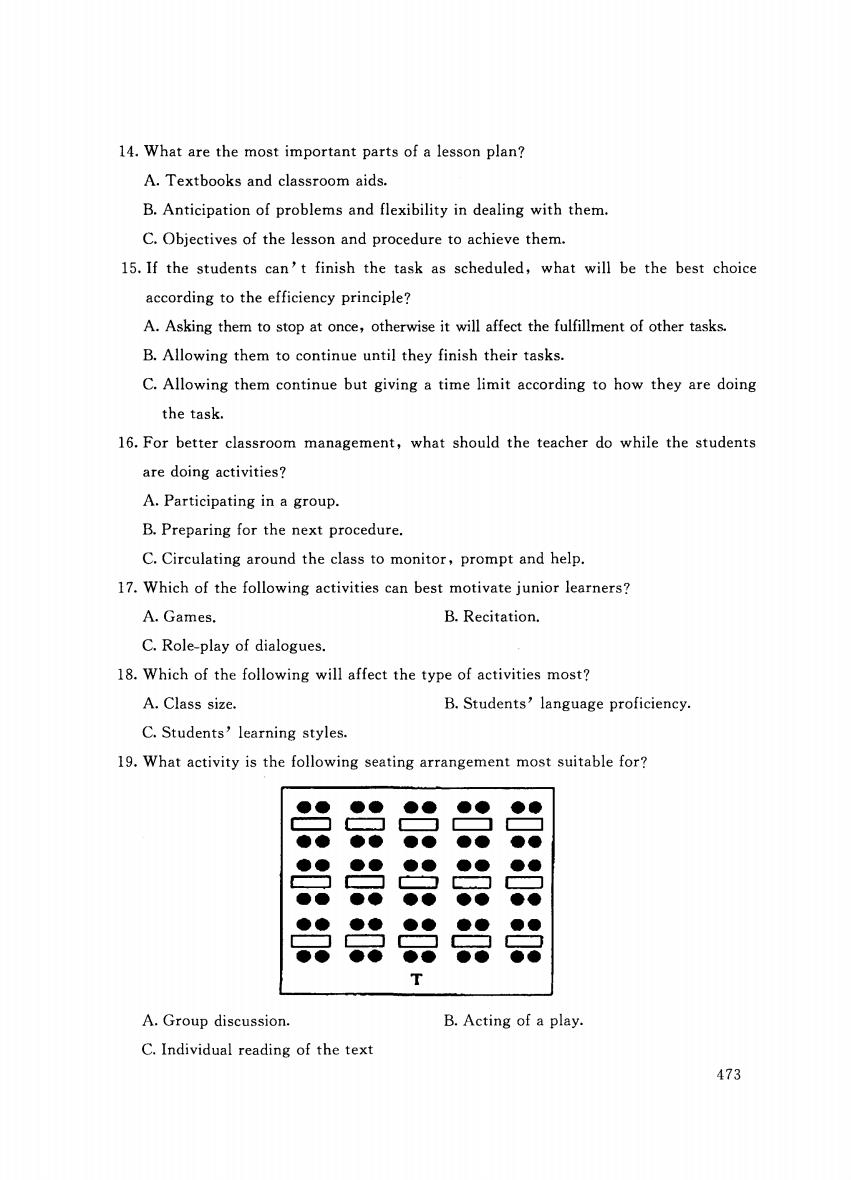
14.What are the most important parts of a lesson plan? A.Textbooks and classroom aids. B.Anticipation of problems and flexibility in dealing with them. C.Objectives of the lesson and procedure to achieve them. 15.If the students can't finish the task as scheduled,what will be the best choice according to the efficiency principle? A.Asking them to stop at once,otherwise it will affect the fulfillment of other tasks. B.Allowing them to continue until they finish their tasks. C.Allowing them continue but giving a time limit according to how they are doing the task. 16.For better classroom management,what should the teacher do while the students are doing activities? A.Participating in a group. B.Preparing for the next procedure. C.Circulating around the class to monitor,prompt and help. 17.Which of the following activities can best motivate junior learners? A.Games. B.Recitation. C.Role-play of dialogues. 18.Which of the following will affect the type of activities most? A.Class size. B.Students'language proficiency. C.Students'learning styles. 19.What activity is the following seating arrangement most suitable for? ●● ●● 兰 T A.Group discussion. B.Acting of a play. C.Individual reading of the text 473
14. What are the most important parts of a lesson plan? A. Textbooks and classroom aids. B. Anticipation of problems and flexibility in dealing with them. C. Objectives of the lesson and procedure to achieve them. 15. If the students can' t finish the task as scheduled , what will be the best choice according to the efficiency principle? A. Asking them to stop at once , otherwise it will affect the fulfillment of other tasks. B. Allowing them to continue until they finish their tasks. C. Allowing them continue but giving a time limit according to how they are doing the task. 16. For better classroom management , what should the teacher do while the students are doing activities? A. Participating in a group. B. Preparing for the next procedure. C. Circulating around the class to monitor , prompt and help. 17. Which of the following activities can best motivate junior learners? A. Games. B. Recitation. C. Role-play of dialogues. 18. Which of the following will affect the type of activities most? A. Class size. B. Students' language proficiency. C. Students' learning styles. 19. What activity is the following seating arrangement most suitable for? C:::::J •• ••::J ••::J [二::J •• C二•• •• •• •• •• •• C::::J •• r=:J •• ••::J C=:J •• C=:J •• •• •• •• •• •• ••::JC••::J C:::J •• •• C:::J [二•• •• •• •• T •• •• A. Group discussion. C. Individual reading of the text B. Acting of a play. 473

20.What is the teacher doing in the following in terms of instruction? "We've got one more minute left,so make sure that you finish your task on time.... OK,I think it is the time. A.Ending the task. B.Evaluating the task. C.Monitoring the task. SectionⅡ:Lesson Plan60 points 21.Directions:In this section,you are presented with a picture.Read the information and design three grammar activities.The requirement of each activity is as followings: >Presentation:present how to use the future tense "be going to..." >Practice:design form-focused activity to practice the structure >Application:use the grammar in real-life activity You may follow the table given after the passage.Make sure the three activities are related to each other. Chen:What are you going to do this weekend? sarah:I'm going to plant trees. Chen:Plant trees? sarah:Yes.I need some plants.So I'm going to the plant shop. What else?Let me see... Chen:Are you going to use any books? sarah:Yes.I'm going to the bookstore.I'm going to buy a magazine about plants. Chen:That's great! sarah:I want to be a science teacher one day! Answer the questions. (1)What is Sarah going to do on the weekend? She is going to (2)Where is Sarah going to buy the plants? 474
20. What is the teacher doing in the following in terms of instruction? "We've got one more minute so make sure that you your task on time. . . OK, I think it is the time. " A. Ending the task. C. Monitoring the task. B. Evaluating the task. Section II : Lesson Plan 60 points 21. Directions: In this section , you are presented with a picture. Read the information and design three grammar activities. The requirement of each activity is 副followings: };> Presentation: present how to use the future tense "be going to... ". };> Practice: design form-focused activity to practice the structure };> Application: use the grammar in real-life activity You may follow the table given after the passage. Make sure the three activities are related to each other. Chen: What are you going to do this weekend? sarah: I' m going to plant trees. Chen ,Plant trees? sarah: Yes. I need some plants. So l'm going to the plant shop. What else? Let me see. . . Chen:Are you going to use any books? sarah: Yes. I' m going to the bookstore. l'm going to buy a magazine about plants. Chen: That's great! sarah: I want to be a science teacher one day! Answer the questions. (1) What is Sarah going to do on the weekend? She is going to (2)Where is Sarah going to buy the plants? 474
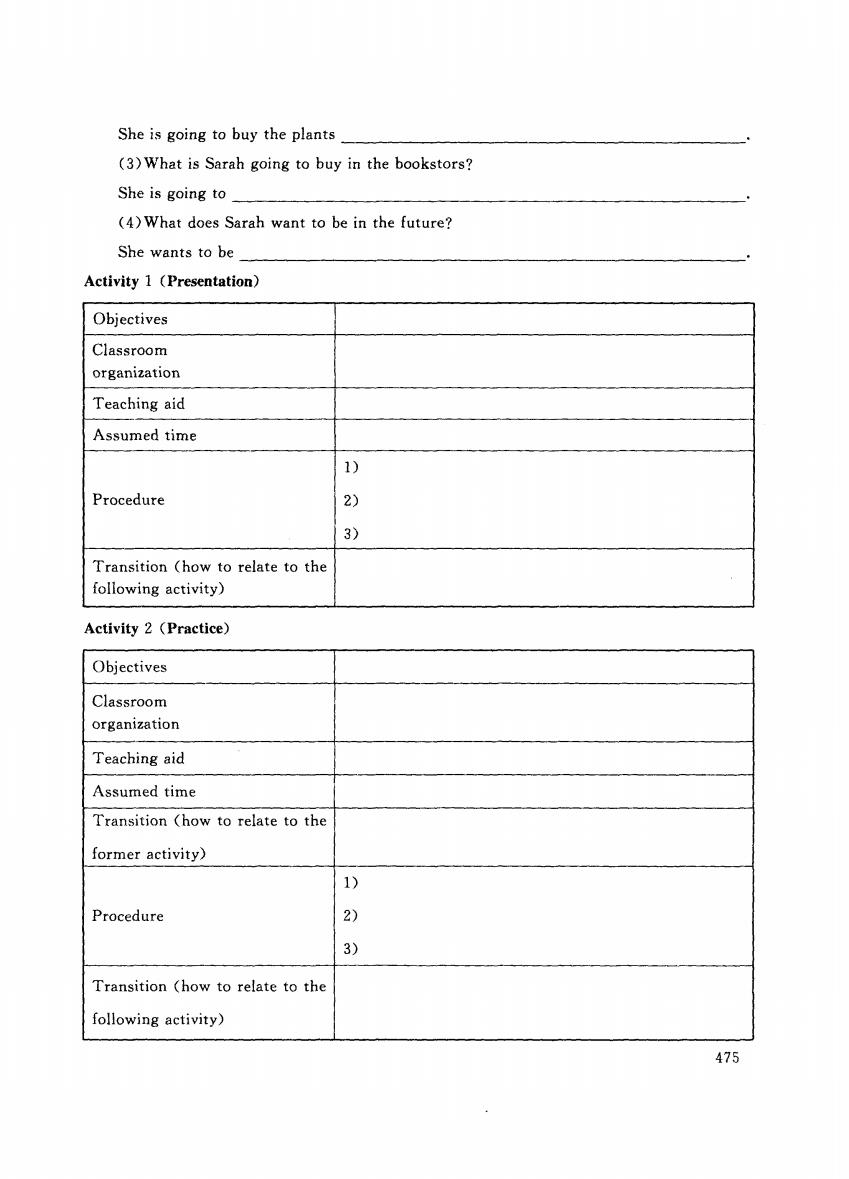
She is going to buy the plants (3)What is Sarah going to buy in the bookstors? She is going to (4)What does Sarah want to be in the future? She wants to be Activity 1 (Presentation) Objectives Classroom organization Teaching aid Assumed time 1) Procedure 2) 3) Transition (how to relate to the following activity) Activity 2 (Practice) Objectives Classroom organization Teaching aid Assumed time Transition (how to relate to the former activity) 1) Procedure 2) 3) Transition (how to relate to the following activity) 475
She is going to buy the plants (3) is Sarah going to buy in the bookstors? She is going to (4) What does Sarah want to be in the future? She wants to be Activity 1 (Presentation) Objectives Classroom orgamzatlon Teaching aid Assumed time 1) Procedure 2) 3) Transition Chow to relate to the following activity) Activity 2 (Practice) Objectives Classroom organizatIOn Teaching aid Assumed time Transition Chow to relate to the former activity) 1) Proc巳clure 2) 3) Transition Chow to relate to the following activity) 475
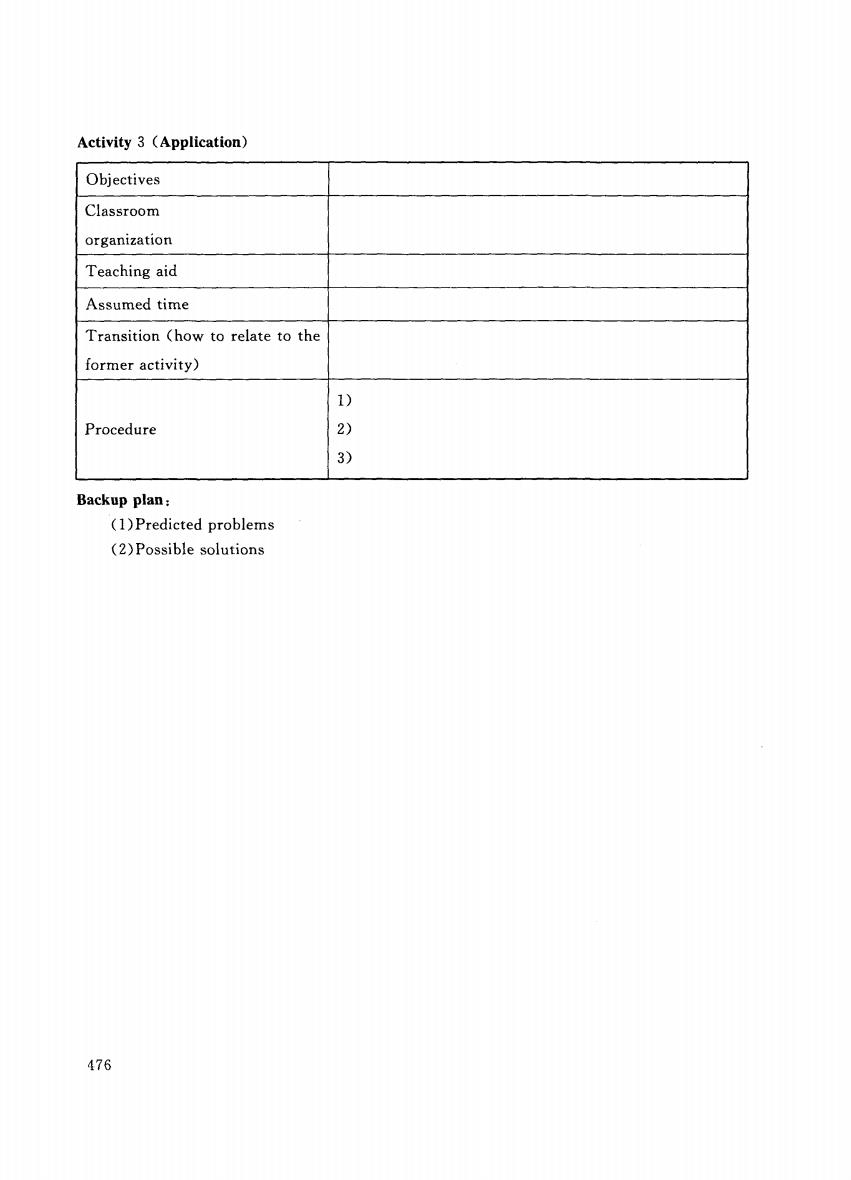
Activity 3 (Application) Objectives Classroom organization Teaching aid Assumed time Transition (how to relate to the former activity) 1) Procedure 2) 3) Backup plan: (1)Predicted problems (2)Possible solutions 476
Activity 3 (Application) Objectives Classroom orgamzatlon Teaching aid Assumed time Transition (how to relate to the former activity) 1) Procedure 2) 3) Backup plan: (1) Predicted problems (2)Possible solutions 476

试卷代号:1065 座位号■ 中央广播电视大学2011一2012学年度第一学期“开放本科”期末考试 英语教学法(2) 试题答题纸 2012年1月 题 号 Section I Section II 总 分 分 数 得分 评卷人 Section I Basic Theories and Principles 40 points 1. 2. 3 4. 5. 6. 7. 8. 9. 10. 11. 12. 13. 14. 15. 16. 17. 18. 19. 20. 得分 评卷人 SectionⅡ:Lesson Plan 60 points 21.Activity 1 Objectives: Classroom organization: Teaching aid: Assumed time: Procedure: Transition:(how to relate to the following activity) Activity 2 Objectives: 477
试卷代号 座位号OJ 中央广播电视大学 11 2学年度第一学期"开放本科"期末考试 英语教学法 )试题答题纸 2012 年1 Section I Section II ,总 21. Activity 1 Objectives: Classroom organization: Teaching aid: Assumed time: Procedure: Transition: (how to relate to the following activity) Activity 2 Objectives: 477

Classroom organization: Teaching aid: Assumed time: Transition:(how to relate to the former activity) Procedure: Transition:(how to relate to the following activity) Activity 3 Objectives: Classroom organization: Teaching aid: Assumed time: Transition:(how to relate to the former activity) Procedure: Backup plan: (1)Predicted problems (2)Possible solutions 478
Classroom organization: Teaching aid: Assumed time: Transition: (how to relate to the former activity) Procedure: Transition: (how to relate to the following activity) Activity 3 Objectives: Classroom organization: Teaching aid: Assumed time , Transition: (how to relate to the former activity) Procedure: Backup plan: (1) Predicted problems (2)Possible solutions 478

试卷代号:1065 中央广播电视大学2011一2012学年度第一学期“开放本科”期末考试 英语教学法(2) 试题答案及评分标准 (供参考) 2012年1月 Section I Basic Theories and Principles 40 points 本题为单选题,共20个小题,总计40分,每题2分。 1.A 2.A 3.B 4.A 5.C 6.A 7.A 8.C 9.B 10.A 11.A 12.A 13.C 14.C 15.C 16.C 17.A 18.C 19.A 20.A SectionⅡ:Lesson Plan 60 points 21.参考答案和评分标准 Activity 1 (Presentation) Objectives:to present how to use "be going to "to talk about future. Classroom organization:pair work Teaching aid:multi-media or OHP Assumed time:6 minutes Procedure: (1)Assign the task(1') "Now,class.In this picture we can see two girls are planting trees.Under the picture, there is a conversation,I'd like you read it with your partner,then discuss when and where “be going to”is used. (2)Students work in pairs to discuss the sentences and talk about their meaning.(2') (3)Feedback and present the grammar item (3') Call on individual pairs to report how they understand.Then the teacher presents the 479
试卷代号 中央广播电视大学 11 2 0 2学年度第一学期"开放本科"期末考试 英语教学法 )试题答案及评分标准 (供参考) 2012 年1 Section I Basic Theories and Principles 40 points 本题为单选题,共 0个小题,总计 0分,每题 2分。 LA 2.A 3. B 4. A 6.A 7. A 8. C 9. B 11. A 12. A 13. C 14. C 16. C 17. A 18. C 19. A Section II : Lesson Plan 60 points 1. 案和 Activity 1 (Presentation) 5.C 10. A 15. C 20. A Objectives: to present how to use" be going to " to talk about future. Classroom organization: pair work Teaching aid: multi-media or OHP Assumed time: 6 minutes Procedure: (1) Assign the task (1') "Now , class. In this picture we can see two girls are planting trees. Under the picture , there is a conversation , I'd like you read it with your partner, then discuss when and where "be going to" is used. (2) Students work in pairs to discuss the sentences and talk about their meaning. (2') (3) Feedback and present the grammar item (3') Call on individual pairs to report how they understand. Then the teacher presents the 479